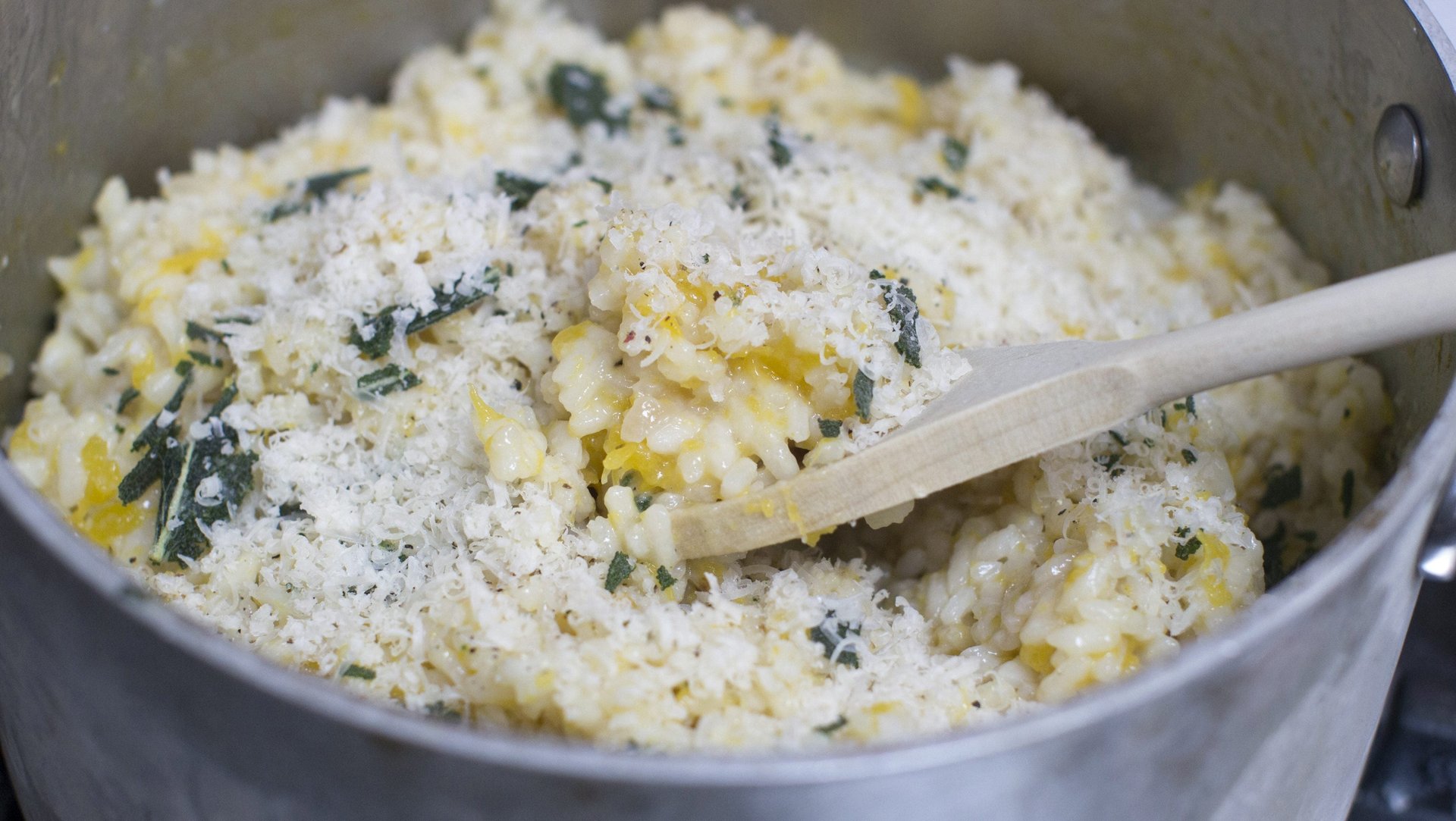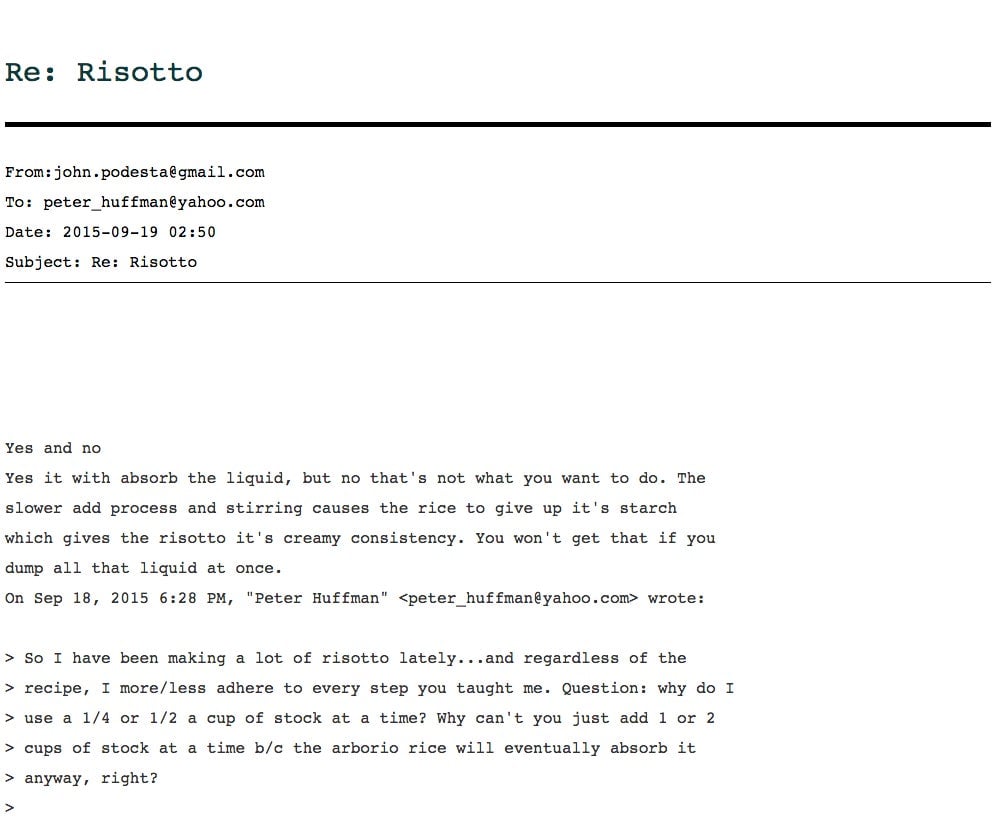I know John Podesta has had a rough couple of days—but he is wrong about risotto, and someone needs to tell America
On Oct. 7, following with uncanny timing the publication of a 2005 video featuring Donald Trump making lewd comments about women, Wikileaks released a series of emails it had hacked from John Podesta, the chairman of Hillary Clinton’s campaign.


On Oct. 7, following with uncanny timing the publication of a 2005 video featuring Donald Trump making lewd comments about women, Wikileaks released a series of emails it had hacked from John Podesta, the chairman of Hillary Clinton’s campaign.
Several aspects of those emails have been commented on and criticized at length, including during the second presidential debate. But there is one topic in particular that could have a long-term impact on American culture and requires tight scrutiny: Podesta’s recipe for risotto.
Searching for “risotto” in the leaks archive brings up four results: one email relating an Associated Press article that mentions Podesta’s renowned kitchen mastery, two making an appointment for a mysterious “Risotto round 2,” and one—subject: Risotto—where Peter Huffman, a financial adviser, asks Podesta an incredibly crucial question about making the dish.

Huffman, who used a Yahoo email as recently as 2015 (because powerful people can get away with anything), writes to Podesta that he has been following his directions when it comes to making risotto. But Huffman is a busy, practical man, and so he wonders:
Question: why do I use a 1/4 or 1/2 a cup of stock at a time? Why can’t you just add 1 or 2 cups of stock at a time b/c the arborio rice will eventually absorb it anyway, right?
Right? Technically speaking, sure.
But, as Podesta informs him, also utterly wrong:
Yes it with absorb the liquid, but no that’s not what you want to do. The slower add process and stirring causes the rice to give up it’s starch which gives the risotto it’s creamy consistency. You won’t get that if you dump all that liquid at once.
Apostrophe misuse notwithstanding, Podesta is right—people don’t add broth to their risotto one ladle-full at a time because they think it’s cathartic to stand by the stove and stir for half an hour (though, it is). They do it because it serves a purpose.
So impressed was I by Podesta’s risotto mastery that I dug further. As it happens, one of his recipes for beetroot risotto was featured in a cookbook, Don’t Cook the Planet: Deliciously Saving the Planet One Meal at a Time (p. 109).
But the beetroot risotto recipe throws into doubt Podesta’s expertise: It turns out he may have been making risotto wrong all his life. Who knows how many others have been doing the same?
There are two problems with Podesta’s recipe, though only one of them is truly concerning. Let’s start with the lesser issue: Podesta recommends using two cups of stock and bringing them to a boil with two cups of water.
That’s a fine shortcut if you’re tired on a work night, but for a recipe to live out in the world? You make the stock, Podesta. Boil carrots, onion, and celery in salted water. Want to add a tomato, a bit of chicken? Go for it. The sky’s the limit.
Now, onto serious business. In his recipe, Podesta prepares the beets before he starts cooking the rice, which is sound advice for any ingredient being added to risotto. But then he suggests the unthinkable: “when the beets are softened and partially cooked, add the rice and 1 tablespoon of olive oil.”
That means add the rice to the beets, doesn’t it? He adds the rice to the beets, doesn’t he?
Sigh. In this one directive, Podesta flubs the most fundamental step of cooking risotto: the soffritto.
Here’s how it should go: In a pot, melt butter (or half butter and half extra-virgin olive oil, which I prefer) and bring it to frying temperature, then add chopped onion. Let the onion fry till it becomes golden, and add the rice. Toast the rice till it absorbs the butter, and add the wine first, then the first bit of broth. Only then you can add your beets, or other vegetables.
Of course, to each his (or her) own. But maybe Podesta should limit his advice to broth dispensation—and political campaigns.